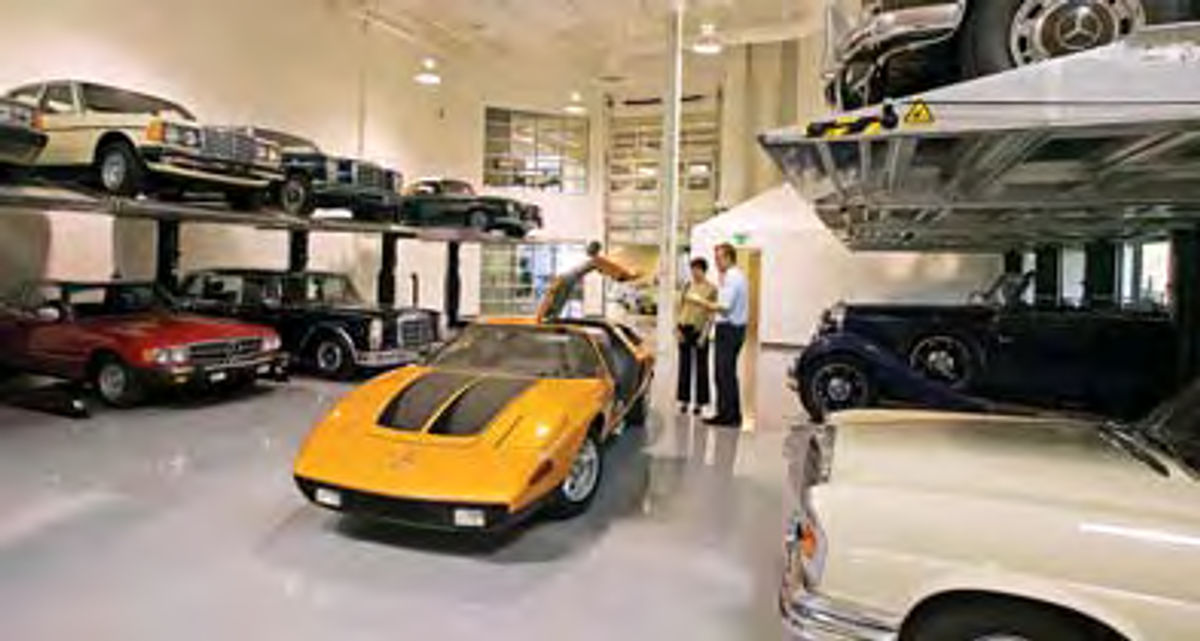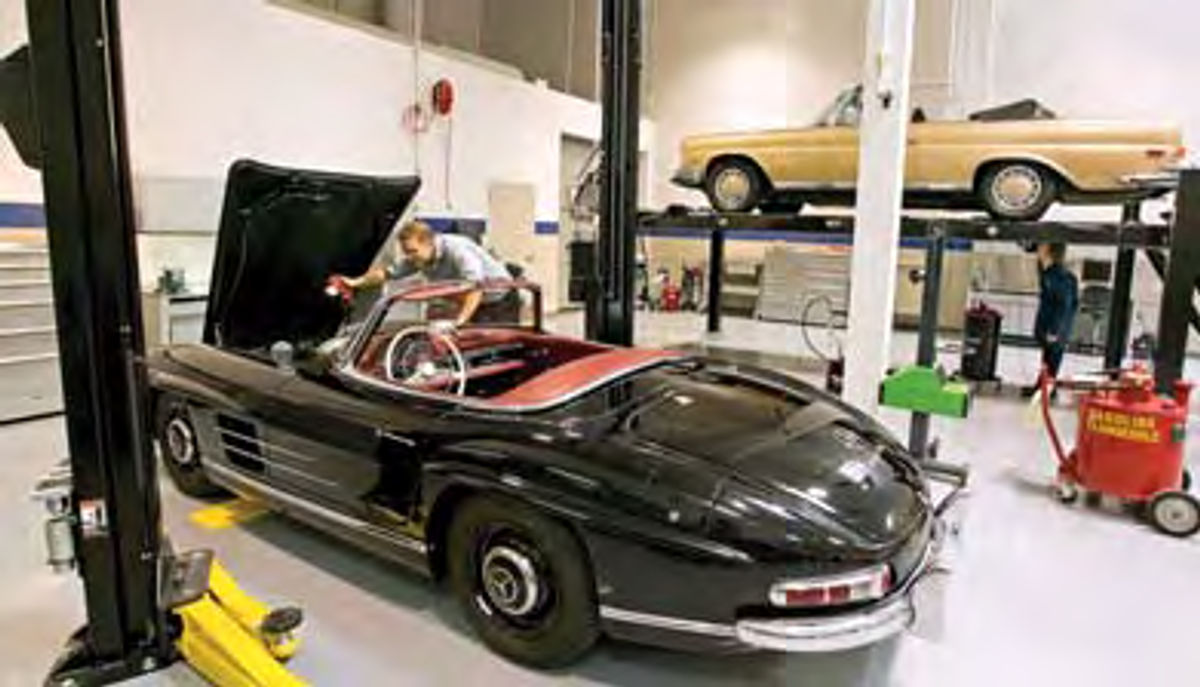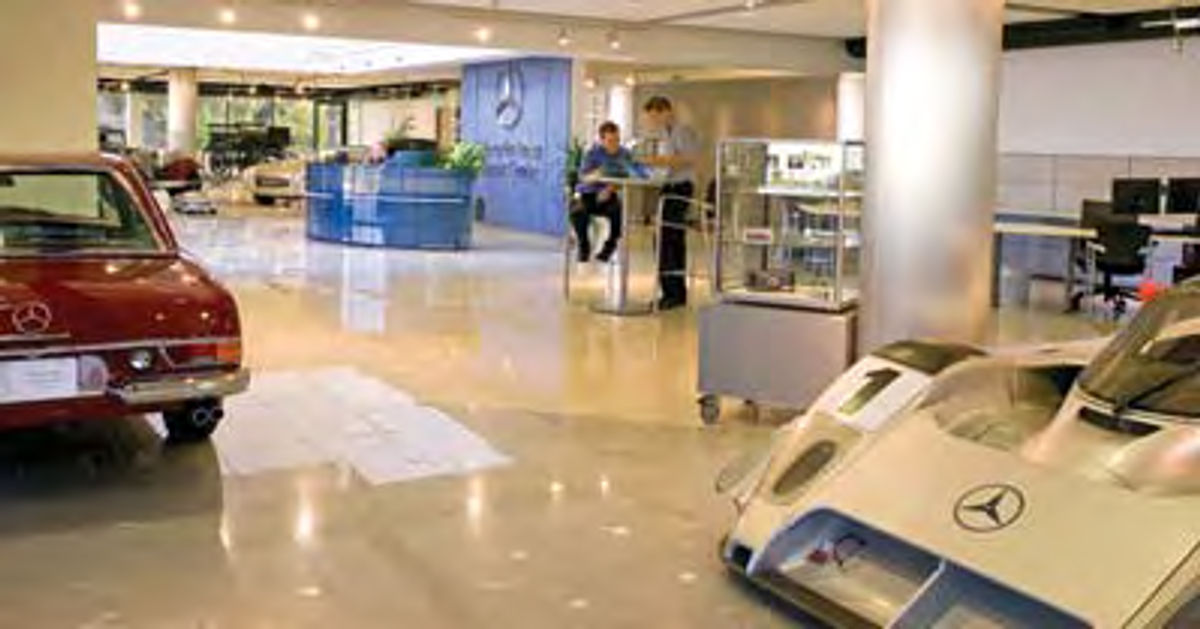The Lap of Vintage Luxury
With a $775,000 1928 MercedesBenz 630 that was coach built in Paris and a 1:1 replica of the world’s first automobile set up for display in the front showroom, the Mercedes-Benz Classic Center seems a bit more like a museum than the type of place where you’d go to buy a used car and car parts or have your engine tuned. Nevertheless, you can do all three of these here, that is, if you own or are in the market for a vintage Mercedes.
Located in Irvine, California, the Classic Center is a 26,000-square-foot facility complete with the showroom displaying a number of restored, vintage Mercedes, two large workshops where customers’ cars are repaired and restored, and a backroom stocked with almost every vintage Mercedes-Benz part that you could ask for.
And don’t forget the gift shop that offers miniature models of classic Mercedes-Benz cars, books on the history of the company and other novelty items such as wine bottle stoppers shaped like a Mercedes gear shift.
All of this makes up “the extended arm of the Classic Center in Stuttgart, Germany,” said the center’s manager, Mike Kunz. As such, the Classic Center in Irvine is part museum, part used car showroom and part body shop.
Back in Germany, the Stuttgart facility originally repaired and serviced all of the “old timers” (what Germans call vintage vehicles) from the neighboring Mercedes-Benz Museum, but in 1993, the company decided to extend this resource to the public.
In 2006, Mercedes further extended this service by becoming the first car manufacturer to offer a facility dedicated to selling, repairing and restoring its vintage vehicles within the U.S.
Irvine, a city where it is uncommon not to see a Mercedes on the street at any one time, was selected as the perfect location for the center.
“It’s the market here,” Kunz said. “It’s very common to own a classic car, and there’s a great car culture in general.”
A sort of Mercedes-Benz Mecca, Southern California harbors more than half of the 550,000 vintage Mercedes cars in the U.S.

The perpetual sunny weather doesn’t hurt either. With the lack of seasons, it’s easy to enjoy owning a convertible at any time of the year and rust is a virtual non-issue for Southern California vintage vehicles.
And we like to think that the real reason they moved into their location at 9 Whatney was to be right down the road from a publication called Auto Restorer.
Not Your Average Used Car
The Classic Center in Irvine sells “classic” Mercedes vehicles, which they define as any Mercedes that has been out of production for 15 years or more. Starting at around $25,000, the sticker prices on these vintage vehicles can reach all the way up into the millions.
“We’re very particular about what we sell,” Kunz said. “The cars have to be excellent, in great condition with a documented history.”
These histories can be quite extensive. Recently, the center sold a 1911 Mercedes-Benz to the tune of a quarter of a million dollars. Originally commissioned by the president of the Canadian Grand Trunk Railway, the Mercedes was built and started its journey. Unfortunately, its owner made the fateful decision to take a ride on the Titanic, leaving the car in the hands of his widow. From there, the car was sold to a number of dealers and collectors including Don Ricardo, a noted collector and former head of the NBC Orchestra, before it finally was purchased by the Classic Center. The nearly century-old car retains its original engine, but, understandably, that has been rebuilt, and a new radiator is being constructed before the center turns over the keys to yet another collector.
The cars that the center acquires are generally in pristine condition, meaning only minor repairs or restorations are needed before they can be offered for sale. Kunz said that they don’t buy fixeruppers to restore and sell as they prefer to use the workshop for customers’ vehicles that need restoration.
Because of the selective process the center uses along with high price tags, the center only sells about a car a month, but they make up for it with the business produced repairing and restoring vintage Mercedes-Benz vehicles.
A Tradition of Originality
“The work we do in our shop runs the gamut from minor tune-ups to major restorations,” Kunz said. And seeing as this is the only center of its kind in the country, Kunz oversees work on cars that are shipped in from all over, some from as far away as Florida and New York.
As we toured the facility, Kunz showed us a couple of restorations in progress, including a full restoration of a ’55 190 SL. Turned upside down on the rotisserie, stripped of its interior, doors, wheels and undercarriage, it certainly didn’t look too impressive, but Kunz pointed out that all of the sheet metal being used in the restoration was stamped out in Germany using company dies and sent over specifically for that job.
This emphasis on originality is a tradition for Mercedes.
“We use original parts, and change things only for safety,” Kunz said. For example, the 1911 Mercedes-Benz used acetylene lighting, which would be lost in today’s roads that are filled with the sharp blue/white of xenon headlights. Things like this will be modified for obvious reasons, but don’t expect the Classic Center to custom fit your ride with 20inch spinner rims anytime soon.

Restoration Boom
Today the center’s workshop is an orchestra of hammers, wrenches and spray guns as the restoration crew works hard on a full load of projects. But finding the right mechanics for these jobs wasn’t easy.
“In the beginning it was a challenge,” Kunz said. “We need mechanics who can work on a broad range of cars and restorers with a lot of experience.”
As well as needing workers with a wide variety of skill sets, the Center also strives to have a good mix of younger and older restorers working in the shop. As mechanics who work on vintage vehicles get older, a new generation must be taught the tools of the trade so that the Mercedes-Benz Classic Center can continue to service its classic cars.
To this end, the Classic Center has established an internship and scholarship program with McPherson College, which offers a degree program in Automotive Restoration Technology.
Having the qualified mechanics to get the job done as well as the ability to provide Mercedes parts straight from the factory in Germany means that restoration jobs don’t come cheap. A full restoration, like that of the ’55 190 SL mentioned above, can set the owner back as much as $250,000 or more.
Kunz said his customers pay this high price for repairs and restorations at the Classic Center because they want perfection as well as drivability.
“They want to use (their cars), and if they’re not running right, even if it’s been fully restored, we go through it and fix the mistakes that were made by others,” Kunz said. “With cars as valuable as these are, it pays to do it correctly.”
So far, vintage Mercedes-Benz owners seem to be onboard with this philosophy, and they have flooded the center with business. While several cars were being worked on in the shop, Kunz took us out back to show us a lot full of vintage Mercedes vehicles waiting their turn for repairs.
“We have a lot of business,” he said. “We’ve somewhat outgrown this facility.” For now, plans are in the works to put up an outdoor lift and take advantage of Southern California’s near-perfect weather for outside work. Long term, though, a new building will be required.
Kunz thinks that in about two years the center will move to a new facility in Irvine where Mercedes can house its impressive collection of vintage vehicles, while having enough space to work on all of the customers’ cars as well.
A Bit of History
As the oldest car company in the world, Mercedes-Benz has always been proud of its well-documented past and eager to share this corporate tradition. According to Kunz, Mercedes founded the first Mercedes-Benz Museum for the public in 1926. This tradition continued with the construction of a brand-new, ultra-modern museum in Stuttgart in 2006, the same year the Classic Center in Irvine opened.

The company’s history dates all the way back to the beginning of the automotive world with the three-wheeled Benz Patent Motor Car, which is claimed to be the world’s first automobile.
Several months after the creation of Benz’s machine, Gottlieb Daimler along with engineer Wilhelm Maybach created a four-wheeled coach or the first “horseless” carriage.
Replicas of both of these historic vehicles are up for display in Irvine.
More than just a relic of the past, the center uses the functional replica of the Patent Motor Car for demonstrations. Kunz said that it runs well and is remarkably easy to use.
Interestingly, the Patent car featured several components that exist to this day in modern automobiles such as rack-and-pinion steering. Of course, because of modern vehicle safety standards, the center can’t sell the Patent replicas as drivers, but they can and do sell them as full-size models, including one we saw in the shop that was on its way to a museum in Asia.
As well as being the first automobile, the Patent car also made history as the subject of the world’s first road trip. Berta Benz, wife of Karl Benz, took the three wheeler out on a journey with her children to see her mother. She had to stop at a pharmacy to purchase fuel, as there were no gas stations, and ended up pushing the vehicle up a steep hill before she finally arrived at her mother’s house. With this landmark trip, Berta gained a vital piece of information for her husband’s business—a second gear was needed for hills.
Historic Vehicles
A number of the cars on display in the Irvine center have been shipped over from the museum in Germany to be shown in American concours d’elegance and have similarly colored histories.
The Classic Center is home to an 1895 Mercedes Velocipede (nicknamed the Velo), which Mercedes claims to be the world’s first production vehicle made from 1895-1901. The Velo in Irvine is all original except for a metal fender that replaced the original wood.
Another classic is the 1909 Blitzen Benz, which set a record for its 142 mph racing speed on Daytona Beach. The Blitzen’s long, narrow body resembles a rocket and elicits images of turn of the century racers, like Barney Oldfield, with their windblown scarves and racing goggles. Though the body is a recreation, it does contain the original 21.5-liter, 4cylinder engine. That’s right, 21.5 liters.
“The pistons are huge; every one is the size of a paint can,” Kunz said.
For a bit of juxtaposition, down the aisle from the Blitzen Benz sits the much more modern 1991 C291 racecar. Used mostly as a qualifying car for C series races, it is now in the care of the Classic Center, which is responsible for all of Mercedes’ retired racers.
Besides racecars, the center houses a wide variety of production cars including the ’35 150 Sportmotor that might be mistaken for a Volkswagen Beetle as well as plenty of pre-war and post-war models that more closely resemble what we have come to recognize as the classic Mercedes-Benz design.
All of these models help tell the storied history of Mercedes-Benz and have a lot to say about the evolution of the modern car in general, which is one of the important tasks that the Classic Center undertakes.
“Participating in events, like the concours, raises awareness and excitement about these historic vehicles,” Kunz said.
Other Services
Along with repairs, restorations and vintage car sales, the Mercedes-Benz Classic Center offers other products and services for its customers as well.
With over 40,000 original parts— everything from washers and screws to seat pads and major assembly pieces— there isn’t much that the center can’t offer to help you with your restoration project. Restorers from all over the country can contact the center and have parts shipped to their homes or workshops.
Also, if you need proof that your car is a legitimate classic Mercedes, the center will provide you with a “Birth Certificate” for $25. All you need is the chassis number of your vehicle and proof of owner-
ship, and Mercedes will search through their extensive archives in Germany, which hold records for every car the manufacturer has produced, and create a Birth Certificate for your car. The certificate displays all of the original data for the car and is signed by the head of the Stuttgart archives.
The Classic Center offers a high mileage award for any of their cars with over 155,000 miles. The award includes a Mercedes traditional Star and Laurel badge to be fixed to the grille of the high mileage vehicle as well as a display certificate and formal presentation folder.
Non-Mercedes owners can enjoy the facility as well. The public is free to stop by and take a look at the old beauties residing in the Center’s showroom or just walk around and get a feel for Mercedes and its history. The facility can also be rented for events or gatherings that might benefit from the ambience of six-figure luxury cars from yesteryear.
If you can’t make it out to California, there’s a chance you can see some of the center’s cars on the silver screen. The Mercedes-Benz Classic Center will rent their classic cars to movie producers or advertisers as long as the work is deemed appropriate and a representative from the center is allowed on the set to make sure that filmmakers aren’t doing anything that could harm the car in order to get their shot. A 1972 Mercedes-Benz 600 from the center was used in the opening sequence of “X-Men 3.”
The Driving Purpose of the Classic Center
In the end, everything that the center offers isn’t just an elaborate way to sell vintage Mercedes-Benzes. “The real purpose is selling a new car,” manager Mike Kunz said. “We’re showing that Mercedes-Benz is the only brand that manages its history as extensively as we do and goes to such great lengths to take care of our customers.”
Selling cars from the turn of the century is meant to show customers that Mercedes are timeless automobiles that, even after decades on the road, are still desirable and, with the services that the Classic Center provides, reliable.
“Owning an old car can be a terrible pain in the neck...if you don’t have the proper support,” Kunz said.
















